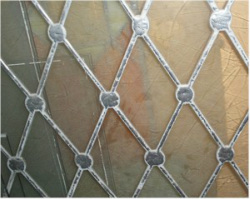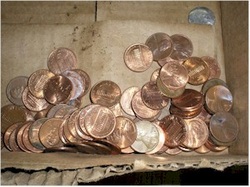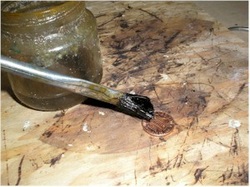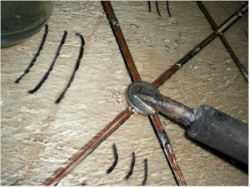How To Add Coining To A Panel For A Very "French" Look
When we work with Candace, a designer of note in Salt Lake City, she loves to have us build windows with "French" diamonds. In another article we showed how to cut the glass in that diamond pattern efficiently. Now we'll show how to achieve the coining look that really makes this glass style pop.

Before we show how to do it right, we have to show our first attempt. In this window, we cut the glass leaving spaces, which we filled with solder, to simulate the coined look. The results just weren't good enough. Some spots were the size of dimes, others the size of quarters. It looked okay, but it just wasn't good enough. We had to abandon 2 weeks work and start over.
*Note how bad the corrosion is on this panel. It was never cleaned after soldering.
*Note how bad the corrosion is on this panel. It was never cleaned after soldering.

To get really good "coining" we reasoned that we were going to have to actually apply real coins. So we started with pennies, after all they would only cost a penny each!
(When we need bigger coins, we get sheet copper (they sell 12 x 12 sheets) and cut out rounds. We tried a scrapbooking punch which worked great till it got dull very quickly. So we used a circle template and placed it over the copper and ran a pencil around it 30 times which wore it out and allowed us to pull the circle out.)
(When we need bigger coins, we get sheet copper (they sell 12 x 12 sheets) and cut out rounds. We tried a scrapbooking punch which worked great till it got dull very quickly. So we used a circle template and placed it over the copper and ran a pencil around it 30 times which wore it out and allowed us to pull the circle out.)

As you start by tinning the pennies (applying a thin coat of solder to them), you'll find that you need to use a strong flux. We used the strongest we have in the studio. There's a lot of corrosion on old pennies.

When soldering, first solder one side by heating the penny and allowing a little solder to melt unto the surface. You'll want to try to coat the surface of the coin evenly. (Gravity will assist you in doing this, but the corrosion on the penny will make it a challenge to get the solder to stick.

You'll want to use a pair of pliers to turn the coin over to solder the backside. The melted solder will start to ooze out from the bottom of the coin and this will help cover the edges of the coin with solder.

Once you have enough coins for both sides of the window, you'll want to wash off the gunk created when tinning them. It would be difficult to clean the back of the coin when it's applied to the glass.

Coins will be applied to all intersections of the diamonds where there's room for them. So start by tacking the entire window together. You'll notice that instead of tacking the glass at the intersections, like normal, we choose to tack the glass away from the joints. This allows an easier install of the coin. We've tried it both ways, this way is faster and easier.

Now, you can lay the coin down and center it over the intersecting lines.

Hold the iron directly on top of the coin and allow the solder to melt under the coin. You'll see it melt on top and then you'll see a little bit of solder run out onto the copper below the coin. The only trick here is to apply even pressure so the coin doesn't start to slide around.

Next, create a bead of solder up each of the lead lines that go under the coin.

Bring the solder right up onto the coin.

Then heat the whole top of the coin so that everything is smooth. You may have to rejoin the lead lines to the coin if too much solder runs under the coin and creates an "undercut" next to the coin.

Continue on, soldering a coin at each joint. When you turn the panel over, simply line up each coin so that it's directly over the coin on the bottom of the panel.
Here are the insulated panels, ready to be installed. You know the job's a success because they look like ancient, old world windows that have been rebuilt.



